|
Special Features





Image Libraries


|
|
Blog
Green-painted bike lanes have become common in DC and around the US. They make bike lanes more visible, helping to remind car drivers to watch for cyclists. But at least 3 other colors are used for the same purpose elsewhere around the world. Here are some examples. Do you know of any others?
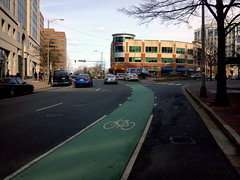
Classic green. Used in DC, New York, and all over the US. |
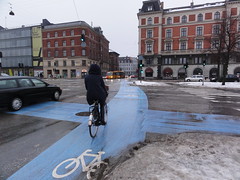
London’s Copenhagen’s blue. Photo by Steven Vance. |
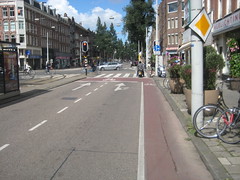
Amsterdam’s dull red, also seen in Vancouver and many other cities. Photo by Scott Lowe. |

Madison’s bright red. Photo by benet2006. |
Average Rating: 4.5 out of 5 based on 232 user reviews.
August 30th, 2013 | Permalink
Tags: bike, galleries, transportation

If you like the FDR and MLK Memorials then you’ll probably like the Eisenhower Memorial. The latest designs follow the now-familiar model for new federal memorials, with an informal stone centerpiece amid a pleasant park.
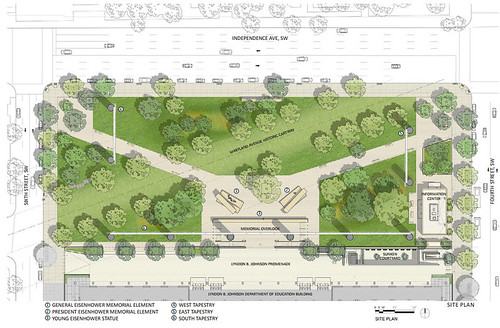
Eisenhower Memorial site plan. All images from NCPC.
Earlier this month, the National Capital Planning Commission (NCPC) released the latest Eisenhower plans, in preparation for a September 12 review meeting.
The proposed design will re-conceive the mess of turn lanes and parking lots where Maryland Avenue SW meets Independence Avenue as a lovely city square. From that perspective, the design is a great victory for DC.
Since the buildings around the memorial are generally uninteresting and devoid of activity, architect Frank Gehry has included several elements that will make the square function as a better and more interesting urban room.
 
Tapestries form the border of an urban room (left), while an amenity-filled promenade helps draw people to the site (right).
Tall tapestries, covered with graphics, will surround and help frame the square, and will hide the eyesore buildings behind. Along the back edge, an activity-filled promenade will add an element of mixed-use, helping to draw more people. The promenade will include a sidewalk cafe, an art exhibition area, and a visitor center.
The memorial itself, at the center of the new square, will consist of stone blocks and metal statues arranged in a casual, informal plan. Like the FDR Memorial, it will be more introspective than monumental.

Central memorial.
The informal stone concept used at FDR and MLK has become popular because it works. Just about everyone likes it, and it doesn’t offend anybody. The same will likely be true for Eisenhower.
But I do wonder how many more similar memorials we can build before the idea becomes a cliche. Ironically, a classical alternative would be more daring.
 Cross-posted at Greater Greater Washington. Cross-posted at Greater Greater Washington.
Average Rating: 4.8 out of 5 based on 203 user reviews.
August 29th, 2013 | Permalink
Tags: architecture, parks, urbandesign

|

Photo from The US Army on flickr. |
News broke this morning that DC may bid for the 2024 Olympics. And predictably, as happens everywhere the Olympics are mentioned, haters immediately started lining up saying how horrible it would be for DC to actually host a games.
Everything they say is true. Hosting the Olympics in DC would be expensive, and a huge hassle, and probably wouldn’t result in much lasting benefit to the city, specifically.
But all the hate still breaks my heart. It’s the civic equivalent of when a school board cuts art & music programs and redirects their funding to standardized mathematics testing. On paper it’s the right decision, but it’s wrong if you want your students to grow up with anything to dream about using math to create.
Art, music, and Olympics are all luxuries, it’s true. But they’re luxuries that are good for the soul. They’re luxuries that make our civilization more than the sum of its parts. They’re things worth doing if we value love.
I love the Olympics, and notably, so do many of the haters, who are happy to watch them on TV when they’re hosted in someone else’s backyard. Don’t we have a term for that?
Average Rating: 4.4 out of 5 based on 300 user reviews.
August 27th, 2013 | Permalink
Tags: in general, social

Spotted last Friday sometime earlier this summer on 14th Street in Columbia Heights:

Yes, this is what it looks like. Original photo source unknown.
Average Rating: 4.4 out of 5 based on 297 user reviews.
August 26th, 2013 | Permalink
Tags: bus, transportation

This panorama is from the 15th floor of one of Ballston’s westernmost buildings, looking east back towards Rosslyn and DC. Bailey’s Crossroads is in the distance at upper right.

Hover your cursor over the image for a labeled version, or click to make it bigger.
Average Rating: 4.4 out of 5 based on 293 user reviews.
August 23rd, 2013 | Permalink
Tags: galleries

Having recently added new rail service to Norfolk and Lynchburg, Amtrak is now beginning planning to extend service to Roanoke.
The plan is simply to extend the highly successful Lynchburg train a few miles further southwest. But since Roanoke hasn’t had rail service in decades, it will take 3-4 years to get everything ready.
Even if progress is slow, it’s exciting to see American intercity rail become popular again.

Amtrak’s route to Roanoke.
 Cross-posted at Greater Greater Washington. Cross-posted at Greater Greater Washington.
Average Rating: 4.8 out of 5 based on 210 user reviews.
August 22nd, 2013 | Permalink
Tags: intercity, maps, The New America, transportation

|
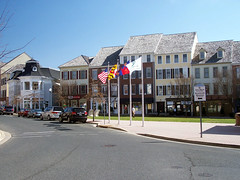
Main Street, Kentlands |
It’s been 25 years since development started at Gaithersburg’s Kentlands, America’s first year-round new urbanist community. With a quarter century of experience under our belt, not to mention a major shift in American development patterns, what have we learned?
When new urbanism hit the big time in the late ’80s and early ’90s, central cities were still declining, and suburbs were still focused around enclosed shopping malls. Generations of Americans had grown up driving around the suburbs, thinking of urban places as crime-ridden ghettos.
New urbanism changed all that. Wherever a new urbanist neighborhood opened, a nice-looking and safe walkable urban place suddenly became accessible to the suburban masses, many of whom had never had one before.
New urbanism reintroduced Americans to the concept of urban living. And as recent history tells us, once we learned urban living was an option, people flocked to it.
New urbanism’s strength is its weakness
But all walkable communities aren’t created equal, and the very thing that made new urbanism initially successful also became its most limiting weakness.
In older urban areas, new urbanist development is indistinguishable from well-designed regular infill. So although new urbanism has many infill projects to its name, the term is more strongly associated with suburban development like Kentlands, where it’s more distinct.
Those suburban new urbanist communities have usually turned out to be internally walkable, but poorly connected to their auto-oriented surroundings. Without the critical mass of a huge walkable city surrounding them, they hit a ceiling. Residents can walk to a corner store and a few cafes, but most of them still need cars to get to work, or really to go anywhere more than a half mile away.
So new urbanism boomed, but those who bought into the concept of urban living quickly deduced that larger and older urban communities offer a superior experience. Kentlands is nice, but compared to places like DC, Arlington, or Silver Spring it’s still relatively isolated, homogeneous, and car-dependent.
Thus, in a twist of fate, new urbanism’s main lasting benefit may be that it’s a gateway for suburbanites to become urbanites — a baby step towards regular urbanism. A necessary step, to be sure, but one quickly passed by.
We do still need new urbanism
Despite the fact that regular urbanism is back, and that new urbanism is no longer the progressive cutting edge of city planning, we still need it in the suburbs.
New growth at the suburban fringe will continue to happen, after all. It always has and it always will; even Dupont Circle was once rural. So we will need a steady stream of new suburban places that are more walkable, more mixed-use, less dependent on the 20th century highway paradigm that has failed so badly. New urbanism remains ideally suited for that purpose.
Regardless of whether or not it’s true that we still need new urbanism to build good cities, we clearly still need it to build better suburbs.
 Cross-posted at Greater Greater Washington. Cross-posted at Greater Greater Washington.
Average Rating: 5 out of 5 based on 280 user reviews.
August 21st, 2013 | Permalink
Tags: history, The New America

Moscow’s subway is among the most heavily used in the world, and surely one of the most beautiful. Many of the stations are decked out in palatial splendor, befitting the communist ideal of grand public spaces. But then there’s 1 station that’s looks almost like it could be from DC. Take a look:
 |
 |
 |
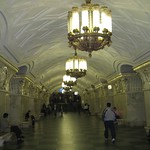 |
All images from flickr. Top photo by Mikhail Vokabre Shcherbakov.
Bottom photos (from left to right) by Adam Nowek, George Armstrong, and macchi. |
Average Rating: 4.4 out of 5 based on 253 user reviews.
August 20th, 2013 | Permalink
Tags: architecture, metrorail, transportation

|

An Amtrak Cascades train leaves Seattle. Photo by KurtClark on flickr. |
Rail use in America continues to climb ever higher. In July, Amtrak posted its busiest ridership month ever. But what are the busiest individual routes?
Let’s take a look. Here are the 10 highest ridership Amtrak routes, as of July, 2013:
Number 1: Northeast Regional
July, 2013 ridership: 687, 331
Number 2: Acela Express
July, 2013 ridership: 276, 477
Number 3: Pacific Surfliner (Southern California)
July, 2013 ridership: 271, 517
Number 4: Capitol Corridor (Northern California)
July, 2013 ridership: 140, 533
Number 5: Keystone Service (NY to Harrisburg, PA)
July, 2013 ridership: 123, 874
Number 6: San Joaquin (Central California)
July, 2013 ridership: 117, 348
Number 7: Empire Service (Upstate New York)
July, 2013 ridership: 99, 801
Number 8: Cascades (Pacific Northwest)
July, 2013 ridership: 85, 565
Number 9: Hiawatha (Chicago to Milwaukee)
July, 2013 ridership: 79, 423
Number 10: Lincoln Service (Chicago to Saint Louis)
July, 2013 ridership: 66, 461
Correction: An earlier version of this story listed ridership data as being for the full fiscal 2013 year. Data is for July, 2013 only.
 Cross-posted at Greater Greater Washington. Cross-posted at Greater Greater Washington.
Average Rating: 4.6 out of 5 based on 234 user reviews.
August 16th, 2013 | Permalink
Tags: intercity, The New America, top10, transportation

Sitting on the ledge of the Dupont Circle fountain and watching humanity roll by is one of DC’s great pleasures. When the weather is nice and the community is out, there’s no other place I’d rather be.
Yesterday evening my wife and I did exactly that. We saw a girl on a tightrope slackline, a huge toga party bike ride, salsa dancing, chess, a harp player, and more. I snapped this handful of cellphone pictures of the activity.
 |
 |
 |
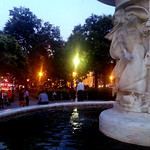 |
| Better than a private lawn. |
Average Rating: 4.5 out of 5 based on 194 user reviews.
August 15th, 2013 | Permalink
Tags: galleries, parks

|
Media





Site
About BeyondDC
Archive 2003-06
Contact
Category Tags:
Partners
|




































